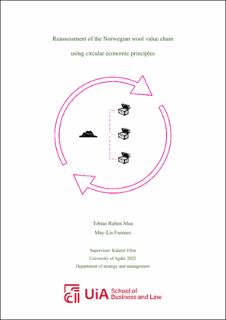| dc.description.abstract | Summary
In this thesis we have followed Norwegian wool from extraction and throughout the current value chain. This includes a farmer, wool stations, and wool refineries. In addition, we have sourced empirical data from key stakeholders. This consists of a representative from Norilia and a researcher that has contributed greatly to the theme of Norwegian wool. Through an exploratory research design, we have been able to enter a field of study without prior knowledge. This has also allowed for incremental implementation of knowledge towards later empirical sourcing.
The theory in the thesis concerns wool as a material, focusing mainly on Norwegian low-category wool, but also includes global perspectives. It also provides theory on circular economy concerning definitions, circular economy perspectives in value chains and the applicability of circular economy.
We have applied the 4Rs of circular economy to reassess the value chain, as a means to uncover potential alternatives to the current system. We believe that circular economy principles can contribute to increased value creation for low-category wool. This entails innovative measures that prevent waste, secure valuable resources inherent in the wool and plan for future use.
The thesis contains examples on alternative uses and processing techniques. These examples explain how conventional methods can be challenged in new ways with improved results. Rather than an addition to the theory of circular economy, this is an attempt to use aspects of circular economy to add to the field that concerns Norwegian low-category wool. The thesis attempts to shine a new light on an established system and challenge its ways. The degree of transferability to other fields is therefore present. We have built upon the work, but not limited to, by Kirchherr on the circular economy, and the work that has been conducted in KRUS and VerdifULL. The process has been an eye opener for us as wool has such a broad range of applicabilities. The same can be said for the circular economy principles.
We hope that this thesis is of interest and gives you, the reader, fruitful takeaways.
Sammendrag
I denne avhandlingen har vi fulgt materialet norsk ull fra ekstraksjon og gjennom den nåværende verdikjeden. Vi har vært i kontakt med en bonde, ullstasjoner og ullraffinerier. I tillegg har vi generert data fra nøkkelinformanter: en representant fra Norilia, og en forsker som har bidratt til vitenskap om norsk ull i stor grad. Gjennom et eksplorativt forskningsdesign, har vi gått inn i et felt uten forkunnskap. Dette har muliggjort en inkrementell implementasjon av kunnskap gjennom den empiriske utviklingen.
Teorigrunnlaget for avhandlingen handler om ull som materiale, med særlig fokus på norsk ull av lavere kategorier, men vi inkluderer også et globalt perspektiv. Det inneholder også teori om sirkulærøkonomi, dets definisjoner, sirkulære verdikjeder, og praktisk anvendelse.
Vi har brukt de fire R-ene i sirkulærøkonomi som rammeverk i vår gjennomgang av ullas verdikjede, for å avdekke potensielle alternativer til det nåværende systemet. Vi mener at sirkulærøkonomiske prinsipper kan bidra til økt verdiskapning for lav-kategorisk ull. Dette innbefatter innovative tiltak som reduserer avfall, sikrer verdifulle ressurser i ulla, og en bedre planlegging for fremtidig bruk.
Avhandlingen inneholder eksempler på alternativ bruk av lav-kategori ull og ulike prosesseringsteknikker. Disse eksemplene forklarer hvordan konvensjonelle metoder kan bli utfordret på nye måter, og gi bedre resultater. Heller enn å være et tilskudd til teorien om sirkulærøkonomi, er dette et forsøk på benytte aspekter innen sirkulærøkonomi for å bidra til feltet som handler om norsk ull av lavere kategorier.
Avhandlingen forsøker å kaste nytt lys på et etablert system, og utfordre det. Graden av overførbarhet til andre felt er til stede. Vi har bygget på arbeidet til, men ikke begrenset til, Kirchherr på sirkulærøkonomi, samt arbeidet som er gjort i prosjektene KRUS og VerdifUll. Prosessen har vært en øyeåpner når det gjelder kartlegging av de mange anvendelsesmulighetene for ull. Det samme kan hevdes når det gjelder å bruke sirkulærøkonomiske prinsipper for å gjennomgå etablerte verdikjeder.
Vi håper denne avhandlingen er interessant, og gir deg, leseren, nyttig læring. | |
